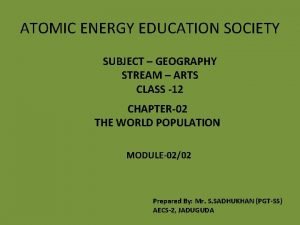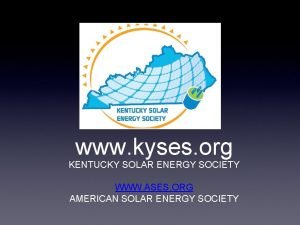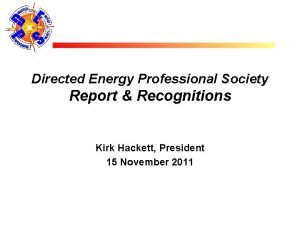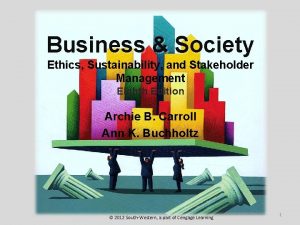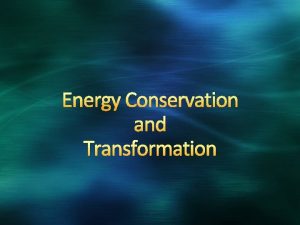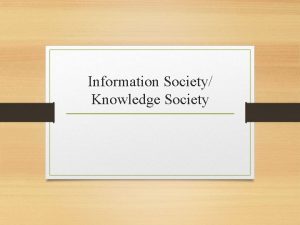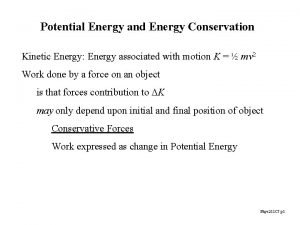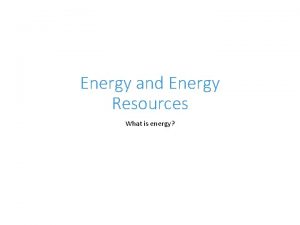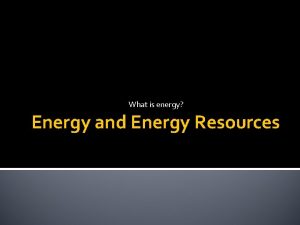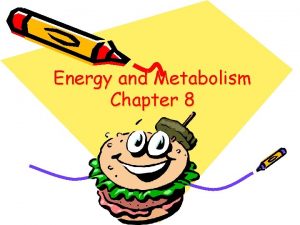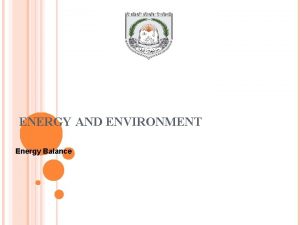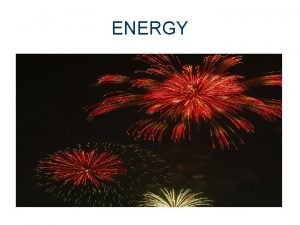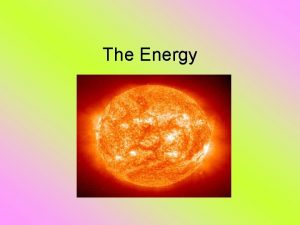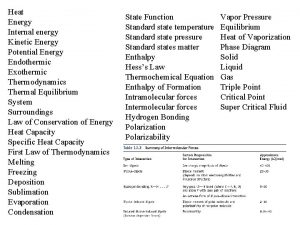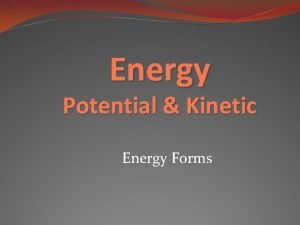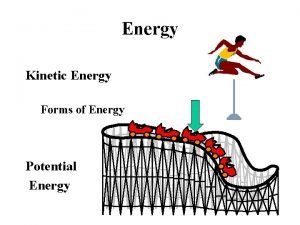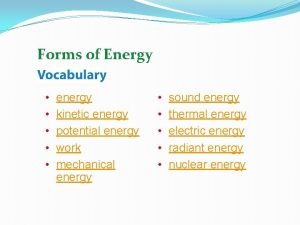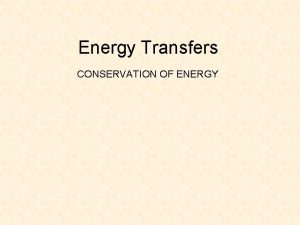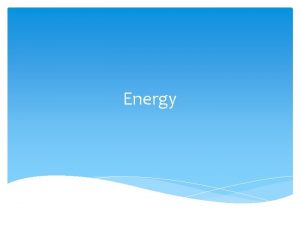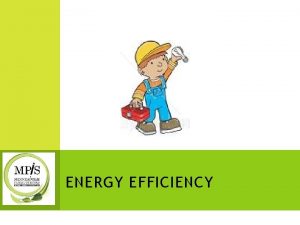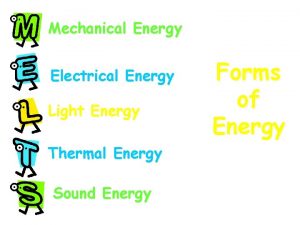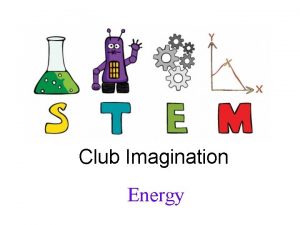Energy and Society ENERGY Energy and SOCIETY Society

























- Slides: 25


Energy and Society

ENERGY Energy and SOCIETY Society

1. Framework

Interrelated areas /dimensions Concepts/Areas Concerns/ prospects HOUSEHOLD LEVEL ENERGY a. Cooking fuel b. Lighting energy Approach Fossil fuel replacing traditional biomass Wastage of energy in lighting, cooking, water lifting, c. Heating/ cooling heating, cooling etc d. Water lifting Loss of traditional practices of cooling/heating/dryi ng Shift to an energy intensive lifestyle Expectations Diverse biomass and efficient stoves or cooking devices Shift to CFL, LED, use of day light and preventing wastage Making the cooking energy renewable Exploring traditional methods of cooling, reducing need for refrigeration Minimize energy use in heating/cooling Motivation to make houses solar passive Awareness about lifestyle issues Optimum use of energy at household level and prevent wastage Positive and sustainable lifestyle

ENERGY LIVELIHOOD A. Agriculture a. Ploughing – Use of animal Vs. Tractor b. Harvesting – Use of hand grinder Vs. Rice mills c. Post harvesting d. Use of modern machinery for agricultural practices B. Energy and Enterprises C. Availability of energy resources and economy of the society Fossil fuel run implements replacing the human/animal muscle power Promotion of low impact livelihood options and practices Creation of more jobs at local level using appropriate technologies Joblessness due to replacement of human power by machines Entrepreneurial opportunity not being trapped as yet Adopting sustainable practices to increase productivity Diversified livelihood to reduced competition Understanding about the role of energy inputs in creating and diversifying livelihood Improvement in the economic status of the society by harnessing energy resources consciously and sustainably Reduced competition

ENERGY IN SERVICE HOSPITALITY INDUSTRY Use of excessive energy and wastage for lighting, water lifting, heating and cooling A. Hotels Use of excessive energy and wastage for transport Water table depletion and pollution in the neighbourhood B. Tourism High investment hotels and tourism industry depriving local community of opportunities and livelihood Promoting Energy efficient equipments Promoting Effective mode of transport and design of routes to minimise use of energy for transport Promoting the Eco-tourism involving of community Replacement with energy efficient equipments Promotion of Locally managed, small scale low impact (Sustainable) tourism Conservative use of natural resources

ENERGY TRANSPORT SECTOR a. Water ways c. Air ways e. Fossil fuel replacing traditional modes of transport Road b. d. Poor public transport system Social inequity due to lack of access Railways Impact on daily mobility of people Widening of gaps due to personalized transport and not meeting people Animal muscle power Poor transport facilities pose barrier for producers, students etc. Promotion of public transport Promotion of ecofriendly and indigenous modes of transport Controlling and minimising the use of energy resources in transport facilities by adopting responsible habits More people use eco-friendly mode of transport More people use public transport Appreciate the use of modern means of transport in view of the economic growth Reduction in energy resources in operating various means of transport at their disposal

ENERGY DEVELOPMENT OF INFRASTRUCTURE FOR THE SOCIETY (Roads, Buildings, Community Halls, Schools, etc. ) A. Energy and social development B. Street lighting Wastage of energy in social institutions Promotion of Green building concept Social vandalism due to absence of street lights Promoting solar for street lighting Women walking long distance for carrying water Decentralised, no energy water supply system (spot sources) Promotion of microhydel Promotion of common facilities like public toilets, agriculture facilitation centre etc. Impact of lack of electric light, poor road etc. on education C. Water supply system D. Education E. Health and Sanitation F. Impact of electrification Understanding about the green building and traditional housing patterns Spot sources of water supply promoted Micro-Hydel promoted Common facilities like public toilets promoted

TRADITIONAL KNOWLEDGE USE OF LOCAL RESOURCES FOR ENERGY A. Practices of using local resources for energy Loss of traditional knowledge and practices Modernisation of society by ignoring the local knowledge of energy resources B. People’s awareness about the economic use of the resources C. People’s awareness about the conservation of the resources Appreciation of traditional knowledge and practices to harness local energy resources Revival of traditional knowledge system Adoption and adaptation of some traditional use or conservation practice for energy, i. e. rain water harvesting

ENERGY LIVESTOCK Shift from biomass to enriched feed for livestock Diverse biomass and adequate storage A. Fodder Introduction of energy intensive implements for livestock rearing Wastage of water due to introduction of stall feeding and sedentary farming B. Modern methods of rearing livestock Reduced employment scope due to advent of energy intensive implements Enough biomass for fodder Promotion of traditional breeds that are less energy dependent Enhancing peoples’ awareness about the sustainable ways to rear the livestock Adopting energy efficient models/methods for rearing the livestock Evaluating the modern methods of rearing the livestock Conserving native breeds of livestock

ENERGY HEALTH Lack of health care facilities due to lack of electricity /regular supply of electricity Promotion of a healthy lifestyle and exercise schedule Increased physical un -fitness due to an energy intensive sedentary lifestyle Decentralised and sustainable sources of energy for healthcare Use of heavy energy dependant equipments in Gyms a. Hospitals b. Gyms c. Day to day physical exercise Minimising the impact of energy systems on human health A healthy and productive society

Some important areas: • Gender-wise energy consumption pattern • Change in the pattern of energy consumption and impact on lifestyle and society • Energy for basic needs and livelihood • Availability of bio-resources and efficient uses in the kitchen • Energy implications of dietary habits • Festival and energy consumption pattern– impacts on society • Change in energy dynamics due to shift in agricultural practices (crop, cattle, fertiliser use) • Common public facilities and impacts on energy consumptions.

Project – 1 Gender-wise energy consumption pattern Methodology Select an area and identify few houses for study. • Collect information about gender and the age classes of the area from the village records • Classify the gender according to the age • Classify the gender and age with respect to economic status • With the help of questionnaire survey and village information sources, list the occupation of the people into classes with respect to gender and express them in percentages such as agriculture, factory, office, school and house. • Mode of transportation: frequency of movement per month and extrapolate to per year against each categories of transportation (this can be done by interviewing people) • Record the frequency of their electricity use by noting the time spent for watching television, lighting (number of bulbs with respect to kitchen, bed rooms, drawing room etc. ), so that relative use of gender in each room/area can be calculated – this is the example for a house. • Compare the relation between economic classes and the gender wise energy expenditure • Similarly, compare the education and occupation also with gender wise energy consumption • Tabulate the results for comparison; come to a conclusion and suggest alternatives for better management Expected Outcome • Gender role in determining and influencing the energy consumption • The gender wise pattern of resource use in the area

Project –II. Energy implications of food and diet Introduction Food is the energy source of all living beings. With the invention of fire and with the social evolution, varieties of food habits arose. Food preparation also accordingly evolved and has grown complex over time. Nowadays the food preparation activities have started consuming a lot of energy and time. From survival it has moved on to become a lifestyle statement. It will be interesting to compare the calorific output of each food item and the energy necessary to prepare it. Objectives To assess the energy required to prepare quantities of different food items, which will provide equal calorie of energy

Methodology • Select different food items of different food styles (Traditional Indian, Traditional to your locality, modern food items, Chinese, etc. ) • Identify the calorific value of each of the food items, by an expert consultation if necessary • Identify the quantities of different types of food items required to provide a particular, given calorie of energy • List out the processes and duration in the course of preparation of each food item • Calculate the energy input in all the cooking processes for each item • Estimate the energy required for preparing each types of food required to produce particular quantities of energy • The results can be illustrated by graphs, box plots etc. • Draw your conclusion. Social relevance of the project This study will help to identify the students to understand the energy costs of taste and lifestyle, which will give a new outlook to the students about the real value of food and their energy implications.

Project – III. Energy spent to stay fit Introduction Energy is a valuable resource of mankind. The resources should be conserved and used for constructive purposes. Nowadays lot many people are regularly exercised in the health clubs and gymnasiums to stay fit. Such exercises lead to burning extra calories of energy from the food taken and avoid the cholesterol formation in the body. This can be easily overcome by managing the qualities and quantities of food consumed, ( which is very important in case of country facing food security problems), and by a physically active lifestyle. An assessment of the energy spent in health clubs and gymnasiums, we will get an idea about how much of the energy which has to be used for the constructive purposes are being used to “stay fit”. Objective Quantify the energy requirement to stay fit

Materials required Pen, papers, etc. Methodology • Calculate the energy required in making a single step of one exercise by one person, e. g. lifting 3 kg of weight to a height of say 1 meter. Thus , W=mgh =3 kgx 9. 8 m/secx 1 meter ( where , m= mass, g=acceleration, h=height ) • Note the numbers of times (n) the exercise is repeted. • Multiply n with w to get total energy (E 1) spent by one person in one exercise. • Similarly calculate the total energy spent by one person in other type of exercises ( E 1, E 2, E 3. . . etc ) • Find the total (E) and average energy spent by one person in one exercise E 1 + E 2+. . + Ex / X = E Where, X is the number of exercises. • Convert the energy in terms of calories • This spent energy on exercises can also be converted to some equivalent amount of typical food. Social relevance of the project The students can identify better methods of energy used to” stay fit. This will also highlight the significance of a physically active and productive life styles of people.

Project – IV. Festivals and change in energy consumption pattern– Impact on Society Introduction: Celebration of festivals in different parts of country witnesses increased energy interactions. This may be by way of cooking, transportation, lighting, firecrackers, etc. Students may be encouraged to explore the ways in which the celebration practices have changed over time and their impact on the health of the community and eco-system. Objectives: • To study the change in the pattern of energy uses in festivals • To find out the amount of energy consumed by a group of households during the festival days. • To compare the energy consumption pattern in the society during festival days and non-festival days. • To suggest ways to reduce the excessive/ unwanted use of energy during festival celebrations

Methodology: Sample: For the study the students should select, randomly, a group of households in their locality. A suggested sample size could be 25 -40 households. Tools: Students should prepare the following types of tools under the guidance of their teachers; • Check Lists of devices used, during the festivals, which consumes energy and the quantity of material/fuels etc. procured and consumed during festival days. • Interview Schedules to collect information from the Heads of households about the practices that require energy for celebrating festivals • Collection and analysis of electricity bills for the festival month(s) and non-festival month(s) to find out the difference in the energy consumption, if any. Techniques: • The students should visit the households before the festival and after the festivals to collect relevant data and information. • If possible, they should collect the information from the field/sample by observing the households during the festivals.

Analysis and Interpretation of the Data: The data/information so collected should be analysed in view of the objectives of the study and it should be interpreted to arrive at conclusions. Expected outcome: • Suggestion of Eco-friendly efforts/measures to be taken up by the society while celebrating the festivals • Awareness levels of public about energy saving techniques particularly for celebrating festivals • Examining people’s sensitivity towards energy conservation while celebrating festivals

Project – V. Common transport facilities to minimize energy inputs and its social impacts Introduction: Human beings are mobile entities and movement from one place to the other is a basic human requirement. We use energy to move from place to place. Before the advent of the modern transport means, people used to walk, ride bi-cycle or go by pull rickshaw or animal pull carts. The use of human and animal muscle power was utilized extensively during those days. At present the dominant energy sources used for transportation is the fossil fuel or electricity. It is noteworthy that in the absence of readily available public transportation system, people take resort to private transportation system. Relying more and more on private transportation increases the consumption level of energy for transportation. Moreover, such individualistic approach of movement isolates the individual from society, reducing the social connectivity. Adaptation of public transportation system helps not only reducing the overall energy consumption but also promotes social connectivity irrespective of class creed and caste. The idea of this project is to see how a good public transport system can impact the economic growth of a society, equity, social harmony apart from reducing energy consumption. Objectives: The objective of this project is to – • Assess the change in means of transport in a locality over a long period of time and the associated energy consumption pattern • Observe how the modernization of transport helped in economic growth of an area • Review people’s perception about equity and how common transport can foster harmony in the society

Methodology: • Select an area for the study • Develop a questionnaire and interview senior citizens in the area about the change in transport system and how it has impacted them • Interview common people about their perception of equity and their idea of travelling together • If there is a school bus / car pool system in any of the local school, interview some students who come by bus and who come alone and find out their perception about ‘friendship’, ‘togetherness’ and ‘cooperation’ • Find out the fuel consumption of a bus and a personal four wheeler / two wheeler. Calculate the per capita consumption in public transportation system and in private transportation system. Compare the results. Expected outcome: • Children will understand how muscle power has been gradually taken over by the modern conventional energy forms • Children will understand the impact of improved transport on the local economy • Children will understand the concept of ‘equity’ and value of ‘togetherness’ Extension/variation: Similar projects may be carried out for common facilities in a village/ locality like a common agriculture facilitation centre where all implements are commonly bought and shared or a common biogas plant or a public toilet etc.

Suggestive project ideas • Assessing livestock value from energy perspective • Innovative energy efficient stoves to utilise locally available bio-residues • Carbon sequestration through community initiatives • Comparison of animal draught power with machines • An investigation about the impact of energy availability on the change on lifestyle of the people • Traditional practice of backyard farming of the non-timber firewood species • Experimental study on conscious reduction in energy use in the household

Ravi kumar. U. N. / 0821 -2544014 / unravi 59@gmail. com
 Energy energy transfer and general energy analysis
Energy energy transfer and general energy analysis Energy energy transfer and general energy analysis
Energy energy transfer and general energy analysis Gertler econ
Gertler econ Atomic energy education society
Atomic energy education society Kyses
Kyses Directed energy professional society
Directed energy professional society Describing energy section 2 answers
Describing energy section 2 answers Primary energy and secondary energy
Primary energy and secondary energy Primary energy and secondary energy
Primary energy and secondary energy Helmholtz free energy and gibbs free energy
Helmholtz free energy and gibbs free energy Renewable energy and energy efficiency partnership
Renewable energy and energy efficiency partnership Potential energy summary
Potential energy summary Potential energy of spring
Potential energy of spring Gravitational potential energy
Gravitational potential energy Kinetic energy and potential energy formula
Kinetic energy and potential energy formula Eroei
Eroei Business and society ethics and stakeholder management
Business and society ethics and stakeholder management Potential energy
Potential energy Gibbs free energy of formation
Gibbs free energy of formation Gibbs free energy vs standard free energy
Gibbs free energy vs standard free energy Conservation of mechanical energy formula
Conservation of mechanical energy formula Thermal energy vs heat energy
Thermal energy vs heat energy A hairdryer converts ____ energy into ____ energy.
A hairdryer converts ____ energy into ____ energy. Energy formula in electricity
Energy formula in electricity How to convert mechanical energy to electrical energy
How to convert mechanical energy to electrical energy Section 3 using heat worksheet answers
Section 3 using heat worksheet answers



